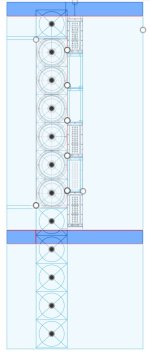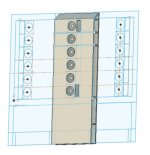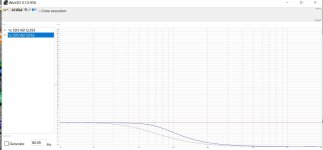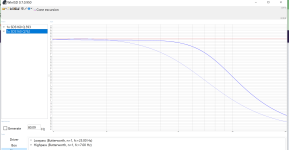I'm working on a line array design that will go behind an acoustically transparent projector screen. The original idea was to use six 6.5" drivers and six Neo8 planars. But modeling in WinISD, and test speakers showed more low-end drop off than I was hoping for. So now I am considering changing the design over to a 2.5-way design; running the six speakers directly behind the screen upto 550 Hz, and the speakers that would be behind or below the projector screen only upto 80 Hz; hoping that the omni nature of the lower frequencies will not give me horrible diffraction artifacts off the projector screen frame and any other gear that happens to be in front of the speaker.
I am leaning towards having all 12 of the 6.5" drivers share a common rear chamber tuned to Q=0.707. My thinking is that as the frequencies rise above 80 Hz that the effective Q of the enclosure will shrink (because the low frequency drivers will be 15 dB down above 200 Hz) - improving impulse response. Is this a bad idea? Do 2.5 way speakers need to have the low frequency driver(s) in their own enclosure for some reason?
For six of the 6.5" drivers:
Q 0.707 = 6627 in^3
Q 0.577 = 16,100 in ^3 Almost 3x the volume required!



I am leaning towards having all 12 of the 6.5" drivers share a common rear chamber tuned to Q=0.707. My thinking is that as the frequencies rise above 80 Hz that the effective Q of the enclosure will shrink (because the low frequency drivers will be 15 dB down above 200 Hz) - improving impulse response. Is this a bad idea? Do 2.5 way speakers need to have the low frequency driver(s) in their own enclosure for some reason?
For six of the 6.5" drivers:
Q 0.707 = 6627 in^3
Q 0.577 = 16,100 in ^3 Almost 3x the volume required!



Last edited:
Q is only defined at resonance.
Around 80 Hz or below, there is no diffraction to worry about.
Get proper DSP EQ and take control?
Are they whetted or sealed?
Do you also use subs?
If also subs, I would seal the mid bass and dimension it to Q 0,5 and EQ it to taste. I think I would do that even if no subs 🙂
//
Around 80 Hz or below, there is no diffraction to worry about.
Get proper DSP EQ and take control?
Are they whetted or sealed?
Do you also use subs?
If also subs, I would seal the mid bass and dimension it to Q 0,5 and EQ it to taste. I think I would do that even if no subs 🙂
//
Last edited:
The line arrays are sealed. I am currently running two cheap subs with dsp/room correction from my pre amp. I really wanted the line arrays to be full range and able to stand on their own. I have a Yamaha CX-5200 pre amp, and when I put the pre-amp in "Pure Direct" mode while listening to records it sounds amazing, but all of the base (and dsp) goes away. I don't miss the dsp, I do miss the bass. I was hoping that if the line arrays were full range (went deep enough) I could have the best of both worlds, the analog magic and the bass.
Thank you for the advice, I think you're correct. Keep the Q low on the enclosures, and then get the room right with dsp on subs only might be the way to go.
Thank you for the advice, I think you're correct. Keep the Q low on the enclosures, and then get the room right with dsp on subs only might be the way to go.
I'm running 12 x 6.5" Speakers per array. I've already purchased 18 Peerless SDS-160F25PR01-08 which have a pretty low reported Fs of 42 Hz (which I measured to actually be 69 Hz unfortunately) so the resonance is a bit below 80 Hz. I've been modeling in WinISD, and I've been thinking about aligning the main listening woofers at Q=0.593 for good transients and the .5 way (sub) drivers at Q=0.762 for good power handling. With a 1st order high pass around 6-7 Hz (to control cone excursion) on both drivers, the sub drivers (box Q=0.762) produce more SPL at the same cone excursion, but require 2.6 times as many watts; 368W vs 141W at max cone excursion.
The below SPL simulation is for an array of 6 drivers:
1W @ Q=0.593 vs 2.6W @ Q=0.762

and
The below cone excursion simulation is for an array of 6 drivers:
141W @ Q=0.593 vs 368W @ Q=0.762

Now I just have to figure out how the hell I'm going to get the lower frequency drivers to receive 2.6 times as many watts with an active cross over?!
The below SPL simulation is for an array of 6 drivers:
1W @ Q=0.593 vs 2.6W @ Q=0.762
and
The below cone excursion simulation is for an array of 6 drivers:
141W @ Q=0.593 vs 368W @ Q=0.762
Now I just have to figure out how the hell I'm going to get the lower frequency drivers to receive 2.6 times as many watts with an active cross over?!

